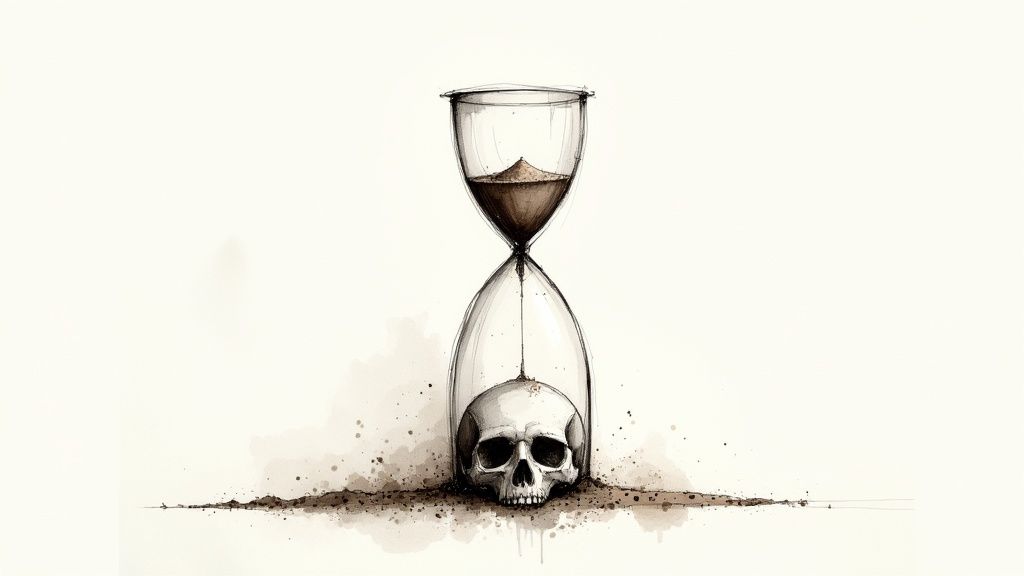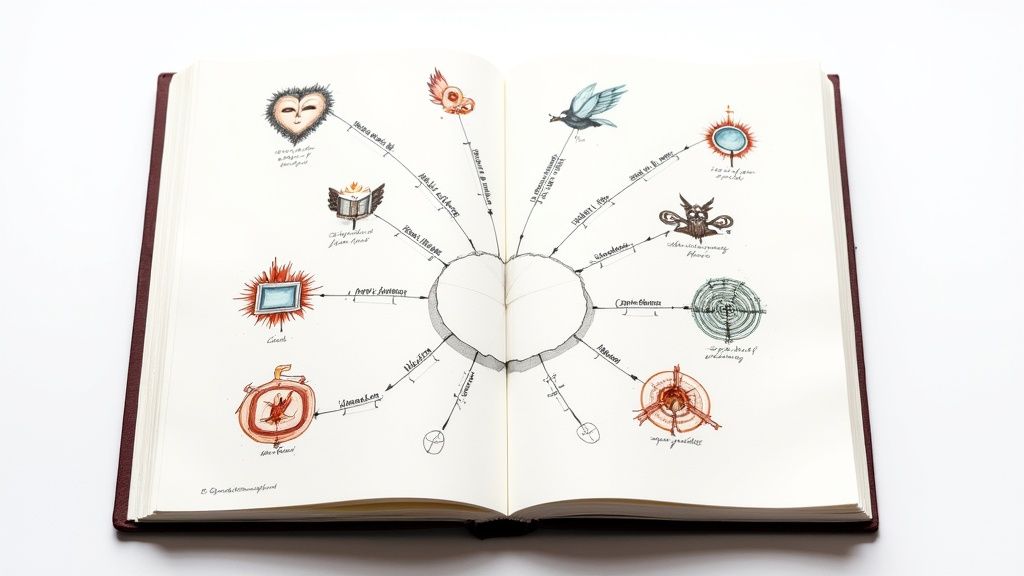7 Unforgettable Examples of Themes in Books (2025 Analysis)

While plot drives the action, theme gives a story its soul. It's the central, underlying idea that resonates with readers long after they've turned the final page. Understanding theme is crucial not just for writers crafting their narratives, but for marketers and publishers aiming to connect a book with its ideal audience. A well-defined theme is a powerful marketing tool, allowing you to articulate a story's core message and emotional impact.
This guide moves beyond simple definitions to provide a strategic breakdown of common examples of themes in books. We will dissect how classic and contemporary authors weave these universal ideas into their narratives, creating profound and memorable experiences. For each theme, we'll analyze specific tactics, offer actionable insights, and provide replicable methods you can apply to your own writing or marketing efforts.
To fully grasp the intricate layers and deeper meanings that constitute a story's theme, effective reading comprehension is vital. Consider exploring resources that explain how text-to-speech can improve reading comprehension, aiding in a more profound understanding of literary works. We will explore powerful themes such as the coming of age, the eternal struggle between good and evil, love, sacrifice, and the individual's conflict with society.
1. Coming of Age (Bildungsroman)
The "Coming of Age" theme, known in literary criticism as the Bildungsroman, is a foundational and deeply resonant narrative archetype. It chronicles a protagonist's journey from youth and innocence to adulthood and experience. This transition is not merely chronological; it involves significant psychological, moral, and emotional growth, often triggered by a specific loss, challenge, or journey away from home.
These stories explore the universal tension between individual identity and societal expectations. As one of the most classic examples of themes in books, the coming-of-age narrative allows readers to witness a character grapple with their place in the world, make formative mistakes, and ultimately forge their own values.
Example Analysis: To Kill a Mockingbird by Harper Lee
Harper Lee’s classic novel is a masterclass in the Bildungsroman. The story is told through the eyes of Scout Finch, a young girl in the American South. Her maturation is driven not by a single event, but by a series of profound experiences related to the trial of Tom Robinson, an innocent Black man falsely accused of a crime.
- Catalyst for Growth: The injustice Scout witnesses shatters her innocent, black-and-white worldview.
- Moral Development: She learns about prejudice, courage, and compassion from her father, Atticus, and her reclusive neighbor, Boo Radley.
- Shift in Perspective: The novel ends with Scout looking at her neighborhood from Boo Radley's porch, literally and figuratively seeing the world from a new, more mature perspective.
Strategic Insight: Lee masterfully uses a child narrator to explore complex adult themes. This contrast allows the harsh realities of racism and injustice to be filtered through a lens of emerging awareness, making the lessons more poignant and impactful for the reader.
Actionable Takeaways for Writers
To effectively weave a coming-of-age theme, focus on the internal journey. The external plot should serve as a crucible for the protagonist's development.
- Establish a Clear "Before": Show the character's initial state of innocence or ignorance.
- Introduce a Defining Conflict: The central conflict must challenge the protagonist's core beliefs.
- Show, Don't Just Tell, Growth: Demonstrate change through the character's actions, decisions, and evolving worldview.
This theme is particularly potent in young adult fiction. For excellent examples of coming-of-age stories, consider exploring some of the most popular YA book series, where character growth often spans multiple volumes.
2. Good vs. Evil
The theme of Good vs. Evil is an archetypal conflict that serves as the backbone for countless narratives across history. It explores the fundamental struggle between moral righteousness and corruption, often personified by heroes and villains. This theme delves into the nature of morality itself, questioning whether good and evil are absolute forces or products of choice and circumstance.

As one of the most powerful examples of themes in books, this eternal conflict provides a framework for exploring sacrifice, courage, temptation, and the very essence of humanity. It forces characters to make profound ethical decisions, revealing their true nature in the process and driving the central tension of the story.
Example Analysis: The Lord of the Rings by J.R.R. Tolkien
J.R.R. Tolkien's epic fantasy is the quintessential story of Good vs. Evil. The conflict is personified by the free peoples of Middle-earth (Good) standing against the Dark Lord Sauron and his armies of Mordor (Evil). The central symbol of this struggle is the One Ring, an object of immense power that corrupts all who bear it.
- Catalyst for Conflict: The rediscovery of the One Ring sets in motion Sauron's plan for domination and the fellowship's quest to destroy it.
- Moral Examination: The story explores how the temptation of power (the Ring) affects different characters. Boromir succumbs to it, while Frodo and Sam resist, demonstrating that moral strength is not tied to physical prowess.
- Symbolic Representation: The darkness of Mordor stands in stark physical and moral contrast to the light and nature of places like Lothlórien and the Shire, making the battle lines clear.
Strategic Insight: Tolkien makes evil a corrupting force, not an inherent one. Characters like Gollum and Saruman were not born evil but were twisted by their lust for power, adding a layer of tragedy and complexity to the theme. This makes the heroes' resistance more meaningful.
Actionable Takeaways for Writers
To create a compelling Good vs. Evil narrative, move beyond simple black-and-white morality. The most engaging stories explore the gray areas.
- Give Evil a Rationale: Provide your antagonists with understandable, if flawed, motivations. This makes them more three-dimensional than a simple force of nature.
- Test Your Heroes: Place good characters in situations where their moral convictions are challenged, forcing them to make difficult choices.
- Show the Cost of Goodness: Emphasize the sacrifices and suffering required to fight for what is right.
This theme is a cornerstone of the fantasy genre, which often uses epic conflicts to explore complex moral questions. To better understand how these themes define different story types, you can explore the relationship between theme and subgenre.
3. Love and Sacrifice
The theme of Love and Sacrifice explores the profound, often painful, intersection where deep affection compels a character to give up something of immense personal value for the well-being of another. This powerful theme isn't limited to romance; it encompasses familial, platonic, and selfless love, demonstrating that true devotion is often measured by what one is willing to lose.
As a core element in many compelling stories, this theme resonates because it examines the ultimate test of a character's love. It forces characters and readers alike to question the nature of love itself and what it truly means to put another person's happiness or survival above one's own. This dynamic creates high-stakes emotional conflict and showcases some of the most potent examples of themes in books.

Example Analysis: A Tale of Two Cities by Charles Dickens
Charles Dickens’ historical novel culminates in one of literature's most iconic acts of sacrifice. The story follows a cast of characters during the French Revolution, centering on the love triangle between Lucie Manette, Charles Darnay, and the cynical lawyer Sydney Carton.
- Catalyst for Growth: Carton's unrequited love for Lucie transforms him from a listless, self-loathing alcoholic into a man with a purpose.
- Moral Development: He sees an opportunity to give his wasted life meaning by saving the life of Lucie's husband, Darnay, who is sentenced to the guillotine.
- Shift in Perspective: Carton sacrifices his life by taking Darnay's place at the execution, finding redemption and peace in his final moments, believing it is "a far, far better thing that I do, than I have ever done."
Strategic Insight: Dickens frames Carton's sacrifice not as a tragedy, but as a triumph of the human spirit. By linking the ultimate sacrifice to personal redemption, he elevates the theme from a simple act of love to a profound statement on a person's capacity for change and grace.
Actionable Takeaways for Writers
To make the theme of love and sacrifice impactful, the stakes must be high and the motivations crystal clear. The sacrifice should feel like a genuine, heart-wrenching choice.
- Establish the Cost: Clearly define what the character is giving up, and why it is so valuable to them.
- Show the Internal Conflict: The decision to sacrifice should not be easy. Show the character’s internal struggle to make the choice more powerful.
- Explore Multiple Forms of Love: Move beyond romance to explore the sacrifices made for family, friends, or even ideals.
This theme is a cornerstone of the romance genre, where character sacrifices often drive the central plot. For writers interested in this area, it is vital to understand the market; explore these book marketing strategies for romance novels to connect with the right audience.
4. Death and Mortality
The theme of Death and Mortality confronts the universal and inevitable end of life. Narratives centered on this theme explore how the awareness of mortality shapes human behavior, relationships, and the search for meaning. It delves into the profound experiences of grief, the concept of legacy, the fear of the unknown, and how characters cope with loss or their own impending demise.

As one of the most powerful examples of themes in books, this topic forces characters and readers alike to question what makes life valuable. By examining the end of life, these stories often illuminate the beauty, purpose, and significance found within it, turning a dark subject into a profound exploration of what it means to be human.
Example Analysis: The Book Thief by Markus Zusak
Markus Zusak’s novel offers a unique and poignant look at mortality by having Death itself serve as the narrator. Set in Nazi Germany, the story follows Liesel Meminger, a young girl who experiences profound loss but finds solace and humanity in words and relationships. Death’s perspective provides a constant, overarching presence of mortality throughout the narrative.
- Catalyst for Growth: The death of Liesel’s brother at the start of the novel and the constant threat of death during the war force her to confront mortality from a young age.
- Moral Development: She learns about the value of life through the kindness of her foster parents, her friendship with Max Vandenburg (a Jewish man they hide), and the power of stories to preserve humanity.
- Shift in Perspective: The story is not about avoiding death but about how people choose to live in its shadow. Death is portrayed not as malicious but as a weary observer, haunted by humans.
Strategic Insight: Zusak’s choice of narrator is a brilliant device. By personifying Death and giving it a compassionate, almost melancholic voice, he subverts reader expectations. This allows the story to explore the brutality of the era without becoming overwhelmingly bleak, instead focusing on the small acts of love and defiance that give life meaning.
Actionable Takeaways for Writers
To tackle the theme of mortality effectively, focus on its impact on the living. The presence of death should serve to heighten the stakes and reveal character.
- Balance Darkness with Hope: Juxtapose loss with moments of love, connection, or beauty. Show how confronting mortality can enrich life rather than just end it.
- Focus on Legacy: Explore what characters leave behind, whether it's memories, stories, or an impact on others.
- Use Death to Reveal Value: The threat or reality of death can clarify what is most important to a character, driving them to act with greater purpose or vulnerability.
5. The Individual vs. Society
The theme of the Individual versus Society is a powerful and enduring literary conflict, exploring the fundamental tension between a person's identity and the pressures of social conformity. It scrutinizes the struggle of a character who challenges established norms, laws, or belief systems, forcing readers to question authority, tradition, and the very fabric of community.
These narratives are driven by the conflict between personal conviction and collective will. As one of the most provocative examples of themes in books, this archetype delves into the costs of both rebellion and assimilation, highlighting the courage it takes to stand alone and the potential tragedy of being crushed by an unyielding social structure.
Example Analysis: 1984 by George Orwell
George Orwell's dystopian masterpiece, 1984, is the quintessential exploration of the individual's hopeless struggle against a totalitarian state. The protagonist, Winston Smith, lives in Oceania, a society where the Party exerts absolute control over every aspect of life, even thought itself.
- Catalyst for Growth: Winston's rebellion begins with a small, private act of defiance: purchasing a diary to record his illegal thoughts. This act represents his first step toward reclaiming his individuality.
- Moral Development: He seeks connection with Julia and a deeper understanding of the Party's lies through the forbidden book by Emmanuel Goldstein. These relationships and discoveries solidify his internal resistance against the Party's psychological manipulation.
- Shift in Perspective: The novel's tragic conclusion, where Winston is broken in Room 101 and learns to love Big Brother, serves as a grim warning. His ultimate defeat underscores the theme that in some societies, the individual cannot win.
Strategic Insight: Orwell masterfully uses the mechanics of the state, like Newspeak and the telescreen, not just as plot devices but as thematic instruments. They represent the systematic dismantling of individuality, making Winston's personal struggle a universal symbol of resistance against oppressive control.
Actionable Takeaways for Writers
To effectively explore the Individual vs. Society theme, the societal structure must feel as real and formidable as any single antagonist. Your world's rules are the character's prison.
- Define the "Society": Clearly establish the specific rules, norms, and consequences of the society your character opposes. What does conformity look like?
- Create Nuanced Conflict: Show both the appeal of fitting in (safety, acceptance) and the high cost of rebellion (isolation, punishment).
- Develop an Authentic Voice: The protagonist's internal monologue and personal motivations must be strong enough to justify their opposition to an entire social order.
6. The Corruption of Power
The theme of power corrupting individuals and institutions is a potent and enduring narrative staple. It examines how the pursuit and possession of authority can erode morality, leading to oppression, tyranny, and psychological decay. This theme often acts as a cautionary tale, exploring the famous adage from Lord Acton: "Power tends to corrupt, and absolute power corrupts absolutely."
These narratives dissect the seductive nature of control and its impact on human behavior. As one of the most resonant examples of themes in books, the corruption of power allows writers to explore political, social, and psychological dynamics, questioning whether anyone can wield great authority without succumbing to its darker temptations.
Example Analysis: Animal Farm by George Orwell
George Orwell's allegorical novella is a stark and brilliant exploration of this theme. The story begins with a noble revolution, as the animals of Manor Farm overthrow their human oppressor, Mr. Jones, to establish a society of equality and justice. However, power soon falls into the hands of the pigs, particularly Napoleon.
- Catalyst for Corruption: The power vacuum following the revolution allows the most cunning and ruthless, Napoleon and his cohort, to seize control.
- Moral Decay: The pigs gradually adopt human vices, rewriting the original commandments of Animalism to justify their greed and luxury. The foundational rule, "All animals are equal," is insidiously amended to, "but some animals are more equal than others."
- Shift in Power Dynamics: The story ends with the pigs becoming indistinguishable from the human oppressors they once overthrew, demonstrating the complete cyclical nature of corruption and tyranny.
Strategic Insight: Orwell uses a simple fable to critique complex political ideologies. By personifying political figures and classes as animals, he makes the mechanisms of totalitarianism and the slow erosion of ideals chillingly clear and accessible to a broad audience.
Actionable Takeaways for Writers
To effectively explore the corruption of power, focus on the gradual nature of the moral decline. A sudden transformation can feel less believable and impactful.
- Show a Gradual Descent: Chart the character's or institution's step-by-step moral compromises.
- Explore the Psychology: Delve into why the character craves power. Is it for security, ambition, or a misguided belief in their own righteousness?
- Provide a Contrast: Include characters who resist corruption or use their limited power responsibly to highlight the central figure's fall.
This theme requires a strong narrative arc. For more guidance on structuring such a story, you can check out these useful story outline examples to help map your plot.
7. Redemption and Forgiveness
The theme of Redemption and Forgiveness explores the profound human capacity for moral recovery and healing. It centers on characters grappling with past transgressions, seeking atonement for their mistakes, and the difficult process of either earning or granting forgiveness. This journey is rarely simple, often involving immense personal sacrifice and psychological struggle.
These narratives delve into the complexities of guilt, the possibility of change, and the power of grace. As a powerful example of themes in books, redemption stories resonate because they affirm the hope that no one is beyond saving and that broken relationships can be mended. They examine whether true atonement is possible and what it costs.
Example Analysis: The Kite Runner by Khaled Hosseini
Khaled Hosseini's novel provides a gut-wrenching and modern exploration of redemption. The story is driven by the protagonist Amir's lifelong guilt over his failure to protect his childhood friend, Hassan, from a brutal assault. This single act of cowardice haunts him for decades, shaping his life and relationships.
- Catalyst for Growth: A phone call from an old friend offers Amir a chance to return to war-torn Afghanistan and atone for his past: "There is a way to be good again."
- Moral Development: Amir's journey back is a physical and spiritual crucible. He must confront his deepest fears, face the man who assaulted Hassan, and risk his life to save Hassan's son, Sohrab.
- Shift in Perspective: Redemption is not achieved in a single heroic act but through the long, painful process of caring for a traumatized Sohrab. The final scene, with Amir running a kite for the boy, shows his atonement is an ongoing commitment, not a final destination.
Strategic Insight: Hosseini makes redemption feel earned by making it incomplete and difficult. Amir's guilt is not magically erased; instead, his atonement transforms into a lifelong responsibility, making the theme more realistic and emotionally resonant.
Actionable Takeaways for Writers
To write a compelling redemption arc, the journey must feel both arduous and authentic. The character's change cannot be superficial; it must be forged in fire.
- Make the Transgression Significant: The initial mistake must be serious enough to warrant a difficult path to redemption.
- Show the Internal Struggle: Focus on the character's guilt, self-loathing, and the immense difficulty of facing their past actions.
- Demonstrate Earned Forgiveness: Redemption should not be given easily. It must be earned through sacrifice, action, and genuine, lasting change.
7 Key Themes Comparison
| Theme | Implementation Complexity 🔄 | Resource Requirements ⚡ | Expected Outcomes 📊 | Ideal Use Cases 💡 | Key Advantages ⭐ |
|---|---|---|---|---|---|
| Coming of Age | Medium – requires nuanced character growth | Moderate – focus on internal conflict | Deep psychological and moral development | Stories emphasizing personal growth and identity | Relatable across ages; universal appeal; emotional catharsis |
| Good vs. Evil | Low to Medium – clear dichotomy but avoid flatness | Moderate – create balanced characters | Clear moral tension and satisfying resolutions | Heroic quests, moral dilemmas | Dramatic conflict; engages universal morality; accessible |
| Love and Sacrifice | Medium – balancing emotional depth and realism | Moderate – depicts complex relationships | Strong emotional resonance and character growth | Romance, family dramas, selflessness narratives | Powerful emotional impact; universal human values |
| Death and Mortality | High – requires sensitive philosophical treatment | Moderate to High – explores grief and culture | Provokes existential reflection and catharsis | Philosophical, tragic, or reflective works | Addresses universal experience; deepens thematic gravity |
| The Individual vs Society | Medium to High – requires social critique layers | Moderate – needs nuanced social context | Encourages critical societal reflection | Dystopian, social commentary, rebellion stories | Relevant social critique; inspires critical thinking |
| The Corruption of Power | Medium – developing gradual psychological shifts | Moderate – integrate political/social contexts | Highlights moral decay and systemic oppression | Political allegories, dystopian fiction | Strong social commentary; compelling conflicts |
| Redemption and Forgiveness | Medium – realistic character transformation | Moderate – explore emotional and moral complexity | Emotional healing and personal transformation | Moral recovery narratives, spiritual themes | Offers hope; promotes compassion; encourages growth |
From Theme to Bestseller: Putting These Insights to Work
We’ve journeyed through some of literature's most powerful and enduring themes, from the coming-of-age struggles in To Kill a Mockingbird to the corrosive nature of power in Animal Farm. Seeing these examples of themes in books is more than an academic exercise; it's a strategic blueprint for creating resonant, memorable, and commercially viable stories. The key isn't just to pick a theme, but to understand its mechanics, its emotional core, and how it has been successfully woven into the fabric of a story.
Each example, from the battle of good vs. evil to the complexities of redemption, reveals a fundamental truth: a well-executed theme elevates a plot from a sequence of events to a meaningful human experience. It's the engine that drives character motivation, shapes conflict, and ultimately, provides the deep satisfaction readers crave.
Strategic Takeaways for Your Writing
To truly master this concept, you must move from passive observation to active application. The analysis of classics like The Great Gatsby or One Flew Over the Cuckoo's Nest provides a treasure trove of tactical insights.
- Actionable Insight 1: Subtlety Over Sermon. As we saw with the theme of individual vs. society, the most impactful stories don't preach their message. They embed the theme within the character's internal conflict and external choices. The reader experiences the theme through the protagonist’s struggle, rather than being told what to think.
- Actionable Insight 2: Thematic Resonance Through Contrast. The theme of love and sacrifice gains its power from what is lost. By establishing high stakes and showing the tangible cost of a character's choices, you create a potent emotional payoff. Without sacrifice, love is just a concept; with it, it becomes an unforgettable force.
- Actionable Insight 3: Universal Truths, Unique Execution. Themes like death and mortality are universal, but their power lies in a unique, specific portrayal. Your goal is not to invent a new theme but to present a timeless one through a fresh lens, using unique characters, settings, and plot points that make it feel new again.
Your Next Steps: From Analysis to Action
Understanding these examples of themes in books is the first step. The next is applying that knowledge to your own manuscript with precision and purpose.
Start by identifying the primary and secondary themes in your work-in-progress. Ask yourself: Is my theme actively driving the plot, or is it a passive backdrop? How do my protagonist's and antagonist's actions embody the central thematic conflict? Use the strategies discussed in this article to dissect your own narrative, strengthening thematic threads and ensuring every scene serves a purpose.
Mastering thematic development is the bridge between a good idea and a powerful, marketable book. It’s what connects your story to the deep-seated human questions that have captivated readers for centuries. By intentionally weaving these timeless concepts into your narrative, you create not just a compelling story, but a work that lingers in the mind long after the final page is turned.
Ready to discover the core themes in your manuscript and get a detailed roadmap for success? ManuscriptReport.com uses advanced AI to analyze your book, identifying its primary themes, comparable titles, and target audience in minutes. Get the data-driven insights you need to refine your story and perfect your pitch at ManuscriptReport.com.
